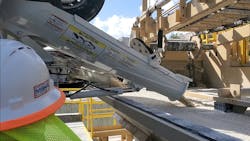Willbee Transit Mix Speeds Washouts with Jadair
Key Highlights
In this article, you will learn:
- About the Jadair Redi-Wash system.
- How the system recovers sand, stone, and water for reuse.
- How the system compares with settling ponds.
Contributed by Jadair.
Willbee Transit Mix operates a fleet of 13 front discharge concrete mixer trucks serving Michigan’s construction markets pours.
Concrete washouts between deliveries are an integral part of the operation’s efficiency.
“[T]he cycle time [on concrete washouts] is critical,” says Stephen Willbee, president. “Between loads, or between color loads, or on a state job when the trucks have to be empty every time, we re-batch.”
Efficient utilization of space is also essential, which is why the fifth-generation family business opted against employing a conventional settling pond, which occupies considerable real estate. In addition to ready mixed concrete, Willbee sells building products, tools, and other supplies.
Small footprint for concrete washouts
“It is important for us to keep [our concrete washout process] compact so we can utilize our property for additional products and more inventory,” said Willbee. Settling ponds also require continual maintenance such as sludge cleanup and repairing or replacing torn liners, which can strain scarce company resources.
To expedite the concrete washout process and reclaim valuable materials, Willbee Transit Mix has used a Jadair Redi-Wash concrete washout system for the past 22 years. He recently replaced the system with a newer model with substantial technological advancements that promised significant productivity gains from the upgrade.
“Our previous system was analog, with dials and switches,” says Willbee. Noting the considerable improvements since his previous system was manufactured, Willbee says, “We had good luck with [our previous] system, so we went right back to Jadair for an updated model.”
Like the original, the updated Redi-Wash Washout System provides both concrete reclamation and water clarification in one self-contained, closed-loop unit. The machine separates and discharges the sand and stone, which enables the complete recovery of those items. The sand is not washed out of the aggregate. The water is clarified and reused for future washouts. Cement fines are discharged separately, and a loader can then handle them easily as a dry, clay-like product.
How washout system works
To perform a washout, a driver simply drives the concrete truck up to the machine and presses a button. The machine adds recycled water to the truck’s rotating cylinder, which then mixes the water with any remaining concrete. The truck then dumps the water and concrete mixture back into the machine and the machine processes and reclaims the materials and recycles the water.
“The drivers pull up, push a button, wait for about 30 seconds and they’ve got their water,” says Willbee. “Depending on what they have in their truck, sometimes they’ll have to cycle another count, but it’s fast, it’s easy. I watched a driver [washout] three yards in about 3-1/2 minutes.”
The streamlined concrete washout system aligns with his motto of “Keep it simple,” Willbee says.
According to Willbee, with the new two-station concrete washout system at their plant, their drivers washout and are back at the plant quickly, ready for re-loading. The system allows them to cycle their trucks in and out of the yard much faster and more efficiently than they previously could.
The biggest factor for Willbee is the time and labor savings.
“If I can save 10 minutes on every trip, by the end of the day that is 70 or 80 minutes,” he says. “That gives us the opportunity to haul another load, so our overall efficiency improves.”
The washout system also recovers a substantial amount of material that can be reused or sold as an additional source of revenue.
Although reclaimed material is not always suitable for high-spec concrete jobs, it can typically be used in lower-spec mixes such as foundations or as base material. Today, these closed-loop, concrete reclamation and water handling units can reclaim all the sand and aggregate from returned loads.
“We have contractors that buy the mixture [of sand and stone] and use it as a base under their new slabs,” says Willbee.
“With this updated system [we] can control the consistency and thickness of the [cement fines] that come out, which is huge,” says Willbee. “Within a couple of days we can get rid of it.” This feature of the system helps keep his plant neat and clean, while reducing maintenance on loaders and other equipment.
In addition to the increased efficiency of Willbee Transit Mix’s washout process, the equipment’s rugged industrial design has held up to the family business’s heavy workload with minimal maintenance.
